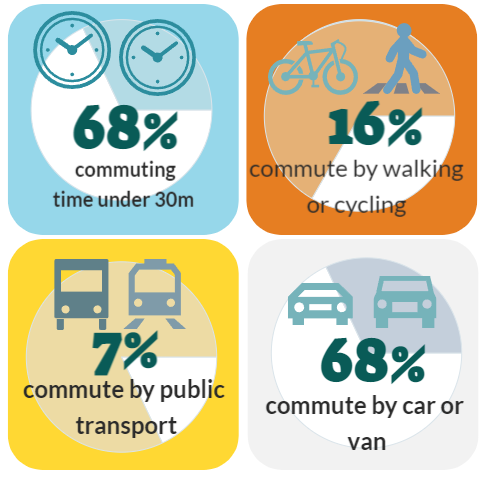2.20 Transport
An effective transport network and public transport are essential for the creation of compact and connected places in the 21st Century. The NPF Ireland 2040 and the RSES for the Southern Region seek to reduce dependence on the private car and shift towards sustainable modes of transport, including walking, cycling and public transport.
Usual Means of Travel – Everyday Commuting Limerick
Based on Census 2016, in Limerick City and County, only 16% used active travel (14.4% walking and 1.5% bike) as their usual means of travel to work, school or college. While rates were higher in Limerick City (27% walking and 2.9% by bike) compared with the County (9.5% walking and 1% by bike), overall active travel rates in 2016 were extremely low and had changed very little compared with 2011.
In 2016, some 68% of persons across Limerick City and County were reliant on the car as the driver (42.8%) or passenger (21.4%) or van (4.1%) as the usual means of transport. Only 7% used a bus / coach or train while 3% worked mainly from home. These data are likely to have changed by 2022 (Census 2022) in favour of active travel, public transport and working from home but not to the extent needed as a response to climate action.

In terms of commuting times, 35% had a commute time to work, school or college of under 15 minutes while 33% had a commute of 15 to 30 minutes. Only 4.5% commute for more than one hour. City residents generally have shorter commuting times - 72% have a commuting time of 30 minutes or under, compared with 66% county residents while 5% of city residents have a commuting time of 45 minutes and over compared with 10% county residents.
Sustainable Travel
Current transport patterns that are highly reliant on the car are unsustainable. However, change in favour of sustainable travel and expansion of public transport services will be challenging in view of the highly dispersed population base in rural Limerick and the strong pattern of cross-commuting to work between the city and county and adjacent counties.
Good public transport links are vital for towns and villages in rural Limerick. Integrating land use and transport (active travel routes, public transport) to help reduce greenhouse gas emissions and facilitate the transition to a low carbon economy are essential needs going forward.
The concept of developing a 10-minute city / town neighbourhoods and vibrant towns and villages, which are compact and offer jobs, services and housing choice provide the basis of strong economies and communities. This model also support a greater range of sustainable modes of transport, both within and between settlements in sub-regions of Limerick.